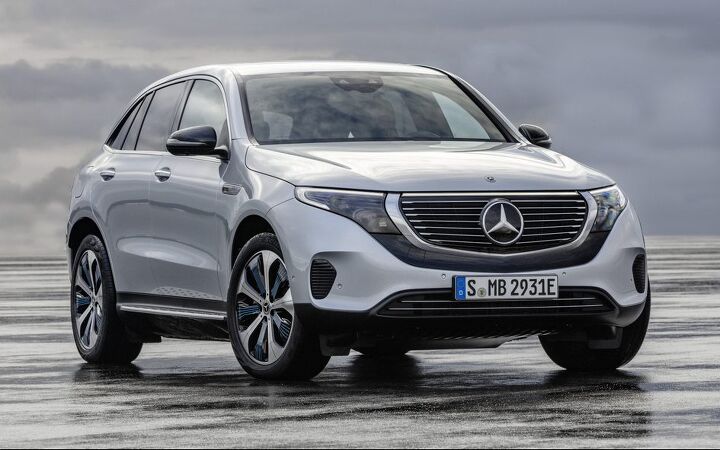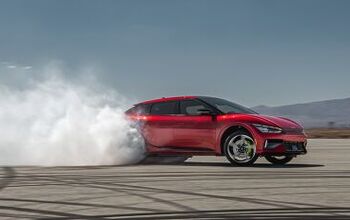Shocker: Electric Cars Are Still, Generally, a Plaything of the Wealthy

Pick your jaw up off the floor. As automakers struggle to offer electric vehicles deemed “affordable” by the motoring public, those buyers aren’t exactly swamping dealers with requests for EVs.
Even in the Europe Union, members of which punish drivers of fossil fuel-powered vehicles with high taxes, EVs amounted to just 2 percent of new vehicles registered last year. And yet the EU plans to drastically cut down on greenhouse gas emissions in the coming years.
New data from the European Automobile Manufacturers’ Association (ACEA) shows that the EU’s green dreams will be hard to realize without some sort of massive incentive for the purchase of electric vehicles, as right now those vehicles are only marginally popular in extremely wealthy countries. The EV “people’s car” is still a dream.
The report shows an EV take rate of less than 1 percent in half of the EU’s member states. The lower a country’s per capita GDP, the lower the take rate.
Only two European countries that boast an EV market share above 5 percent are Sweden and the Netherlands. Finland clears the 3.5 percent mark. What all three countries have in common is a per capita GDP greater than $47,000. Those sub-1-percenters? They all have per capita GDPs below $32,500.
ACEA’s findings show that more than 80 percent of the EU’s electric vehicle sales originate in just six countries, all of them wealthy. On the lower income end of the scale, Latvia sold just 93 EVs last year. Poland boasts a take rate of 0.2 percent, while Slovakia and Greece barely top that, at 0.3 percent.
Automakers have miles to go before the “common man” begins snapping up electric cars in numbers large enough to satisfy the EU. And scarce, unprofitable $35,000 EV sedans are not that vehicle.
Sure, the study’s findings hardly come as a surprise, as high battery costs necessitate a vehicle with a price tag capable of recouping those additional expenses. Profitability can’t be an afterthought in a declining sales environment. Who’s fielding splashy new EVs these days? Jaguar, Mercedes-Benz, Audi, and other luxury brands. While companies like Nissan and Renault are still big players in the EV game, even those brands’ electrics aren’t bargain basement strippers with rock-bottom MSRPs.
If governments try to legislate away the existence of ICE-powered vehicles, they just might find themselves facing an angry, carless society. The solution, according to the ACEA, is more government intervention.
“Besides investing in charging infrastructure, governments across the EU need to put in place meaningful and sustainable incentives in order to encourage more consumers to make the switch to electric,” said ACEA Secretary General Erik Jonnaert at a press conference in Barcelona.
“People throughout the EU should be able to consider purchasing an electric vehicle – no matter which country they live in – north or south, east or west. The affordability of the latest low- and zero-emission technologies needs to be addressed by governments as a matter of priority.”
On the manufacturing side of things, several automakers hope to achieve their goal of an affordable EV. Honda has a new EV city car on the way for European buyers, price tag unconfirmed. Volkswagen’s MEB platform, which forms the underpinnings of a massive product tsunami, will one day propel a car with a price tag in the low $20k range, VW says. The automaker has tapped its Seat brand to lead the affordable EV charge.
Meanwhile, Chinese automakers hope to capitalize on the dearth of low-priced EVs with offerings like the Geometry brand, a creation of Geely Auto Group.
With Europe struggling to make EVs a “thing,” one wonders what domestic automakers can expect when their upcoming electrics land in a market soaked in cheap gas and with no upper limit on vehicle or engine size.
[Images: Nissan, Daimler AG]

More by Steph Willems
Latest Car Reviews
Read moreLatest Product Reviews
Read moreRecent Comments
- Bd2 Lexus is just a higher trim package Toyota. ^^
- Tassos ONLY consider CIvics or Corollas, in their segment. NO DAMNED Hyundais, Kias, Nissans or esp Mitsus. Not even a Pretend-BMW Mazda. They may look cute but they SUCK.I always recommend Corollas to friends of mine who are not auto enthusiasts, even tho I never owed one, and owned a Civic Hatch 5 speed 1992 for 25 years. MANY follow my advice and are VERY happy. ALmost all are women.friends who believe they are auto enthusiasts would not listen to me anyway, and would never buy a Toyota. They are damned fools, on both counts.
- Tassos since Oct 2016 I drive a 2007 E320 Bluetec and since April 2017 also a 2008 E320 Bluetec.Now I am in my summer palace deep in the Eurozone until end October and drive the 2008.Changing the considerable oils (10 quarts synthetic) twice cost me 80 and 70 euros. Same changes in the US on the 2007 cost me $219 at the dealers and $120 at Firestone.Changing the air filter cost 30 Euros, with labor, and there are two such filters (engine and cabin), and changing the fuel filter only 50 euros, while in the US they asked for... $400. You can safely bet I declined and told them what to do with their gold-plated filter. And when I changed it in Europe, I looked at the old one and it was clean as a whistle.A set of Continentals tires, installed etc, 300 EurosI can't remember anything else for the 2008. For the 2007, a brand new set of manual rec'd tires at Discount Tire with free rotations for life used up the $500 allowance the dealer gave me when I bought it (tires only had 5000 miles left on them then)So, as you can see, I spent less than even if I owned a Lexus instead, and probably less than all these poor devils here that brag about their alleged low cost Datsun-Mitsus and Hyundai-Kias.And that's THETRUTHABOUTCARS. My Cars,
- NJRide These are the Q1 Luxury division salesAudi 44,226Acura 30,373BMW 84,475Genesis 14,777Mercedes 66,000Lexus 78,471Infiniti 13,904Volvo 30,000*Tesla (maybe not luxury but relevant): 125,000?Lincoln 24,894Cadillac 35,451So Cadillac is now stuck as a second-tier player with names like Volvo. Even German 3rd wheel Audi is outselling them. Where to gain sales?Surprisingly a decline of Tesla could boost Cadillac EVs. Tesla sort of is now in the old Buick-Mercury upper middle of the market. If lets say the market stays the same, but another 15-20% leave Tesla I could see some going for a Caddy EV or hybrid, but is the division ready to meet them?In terms of the mainstream luxury brands, Lexus is probably a better benchmark than BMW. Lexus is basically doing a modern interpretation of what Cadillac/upscale Olds/Buick used to completely dominate. But Lexus' only downfall is the lack of emotion, something Cadillac at least used to be good at. The Escalade still has far more styling and brand ID than most of Lexus. So match Lexus' quality but out-do them on comfort and styling. Yes a lot of Lexus buyers may be Toyota or import loyal but there are a lot who are former GM buyers who would "come home" for a better product.In fact, that by and large is the Big 3's problem. In the 80s and 90s they would try to win back "import intenders" and this at least slowed the market share erosion. I feel like around 2000 they gave this up and resorted to a ton of gimmicks before the bankruptcies. So they have dropped from 66% to 37% of the market in a quarter century. Sure they have scaled down their presence and for the last 14 years preserved profit. But in the largest, most prosperous market in the world they are not leading. I mean who would think the Koreans could take almost 10% of the market? But they did because they built and structured products people wanted. (I also think the excess reliance on overseas assembly by the Big 3 hurts them vs more import brands building in US). But the domestics should really be at 60% of their home market and the fact that they are not speaks volumes. Cadillac should not be losing 2-1 to Lexus and BMW.
- Tassos Not my favorite Eldorados. Too much cowbell (fins), the gauges look poor for such an expensive car, the interior has too many shiny bits but does not scream "flagship luxury", and the white on red leather or whatever is rather loud for this car, while it might work in a Corvette. But do not despair, a couple more years and the exterior designs (at least) will sober up, the cowbells will be more discreet and the long, low and wide 60s designs are not far away. If only the interiors would be fit for the price point, and especially a few acres of real wood that also looked real.



































Comments
Join the conversation
I can see it now we'll all be riding bikes to save the environment and then when there are too many bikes we will be asked to walk.
IMHO, the great melting pot experiment has worked. It's just that we can't add "ingredients" too fast. We had similar problems with immigrants not assimilating before, back in the late-19th/early-20th century. The solution back then was to shut immigration down for a few decades. People reminisce about the golden years for blue-collar workers in the 1950s, not realizing that the proportion of foreign born population back then was 5%, far down from 15% back in 1920, which is when we started severely restricting immigration. The problem now is that over the last few decades the proportion of foreign born population has crept back up to 15%, with all the attendant problems. It's no wonder the vast majority of Americans want to restrict immigration again, especially illegal immigration. And I think we're starting to see the effects of immigration restrictions now, with rising blue-collar wages.